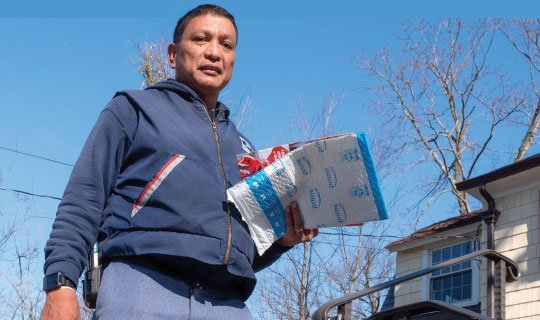“The knee surgery was the best decision I’ve made. I should’ve done it a long time ago."

Imagine walking 35,000 steps every day, often up and down stairs, and with a painful knee.
That was Ben Alano’s daily routine as a postal carrier in Nutley.
His left knee started hurting six years ago. By 2019, he was bowlegged—on the left side only—and limped through his route, which by then took him eight hours to complete rather than the usual six.
“It hurt to put pressure on my knee, which made me favor the other side, and my back began to hurt, too,” says Alano, 55. Massage and over-the-counter pain relievers failed to deliver relief. “Psychologically, it was rough,” he recalls.
But after 25 years as a carrier, he wasn’t about to retire. “I love my job,” he says. “I like getting to know and talk with the customers, and I like having a physical job that keeps me fit.”

Fortunately, some of those customers offered a solution. They told him about orthopedic surgeon Frank Femino, MD, Medical Director of the Joint and Spine Institute at Clara Maass Medical Center, who’d done their own knee replacements. “They said, ‘Go to him. He’s great,’” Alano recalls.
A Gradual Approach
From their first appointment, Alano found Dr. Femino reassuring and thorough. The surgeon explained that osteoarthritis, sometimes called “wear-and-tear arthritis,” had eroded the articular cartilage that buffers the joint between the tibia in the calf and the femur bone in the thigh.
“This can cause your leg to bend outward,” Dr. Femino says. “In fact, Ben’s bowleggedness was really pronounced. That kind of deformity is called varus.” In addition, the condition had caused the mail carrier to transfer stress to his hip, back and ankle, making his discomfort unrelenting.
Alano suspects his years of playing basketball while in high school and college in Manila, the Philippines, played a role in his condition. “It’s so easy to twist your knee as you jump, land and run,” he says.
While some surgeons insist on operating immediately, Dr. Femino believes the patient should set the schedule. “I’m not just treating the knee, I’m treating the person—and they’ve got to be ready for surgery,” he says.
Alano was not, so they started with conservative measures: physical therapy, pain relievers and a brace to stabilize the knee. Dr. Femino also injected anti-inflammatory corticosteroids to the joint. Since the mail carrier was otherwise in great shape, weight loss and exercise weren’t prescribed.
“He was in so much pain that he had a tan line from his brace because he never took it off,” Dr. Femino recalls.
“Eventually, I couldn’t handle the pain any longer,” Alano says. “My knee was bone-on-bone and wasn’t going to improve.”
They scheduled knee replacement surgery for January 2021.
Outpatient Surgery
“Knee replacement is a resurfacing or retreading of the articular surfaces of the knee—where the femur, tibia and kneecap meet—followed by the placement of an artificial joint,” says Dr. Femino. “The surgery is minimally invasive and quad-sparing. Not cutting muscles means less postsurgical pain and a speedier recovery. It’s also an instant cure for osteoarthritis of the joint.”
Not only is the surgery state-of-the-art, but it also leaves a less-than-five-inch cut. “He did such a beautiful job that sometimes you cannot see the scar,” Alano says. Within hours of the one-hour operation, Alano was making his way down hospital corridors with the use of a walker. He went home to his wife the next day.
The Joint and Spine Institute takes a team approach. Physical therapy is set, medical equipment including a walker is ordered and a case manager is assigned.
Alano says he was wowed by how easy the entire process was. “Patients don’t have to worry about the details,” says Dr. Femino. “We let them know in advance what the timing will be and what each step will include. Well-prepared patients feel much better and do much better. Ben was younger than many who have this procedure and was really gung ho, so his recovery was even faster.”
For the first two weeks post-surgery, a physical therapist came to Alano’s home. After that, he did a month of outpatient therapy. “That was the toughest part,” he admits.
Within three-and-a-half months, he was fully recovered and no longer bowlegged, so he was able to return to his mail route. He also is back to his normal speed and gait and has full range of motion.
His life has transformed, with travel plans on the horizon. “Before, it was frustrating when I’d go on vacation and couldn’t do what I wanted. Now I can do whatever I want.
“The knee surgery was the best decision I’ve made,” Alano says. “I should’ve done it a long time ago.”
Ready to stop the pain? Make an appointment for orthopedic services at Clara Maass Medical Center today!